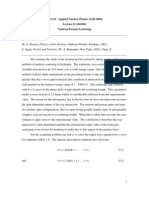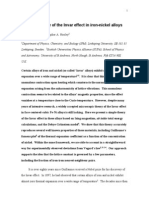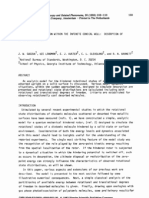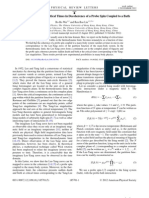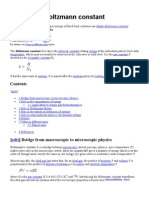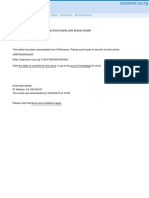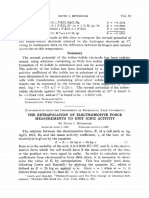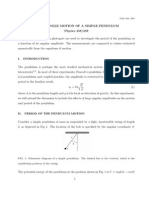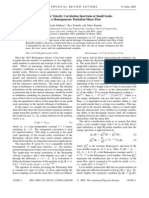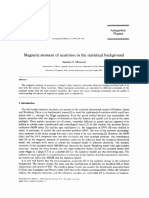Magnetization Curves of A Spin-One Bethe Lattice: PH - V.rrc.c. L MR Wri, Shef/rrld, Sheffield 7Rh. Uk
Magnetization Curves of A Spin-One Bethe Lattice: PH - V.rrc.c. L MR Wri, Shef/rrld, Sheffield 7Rh. Uk
Uploaded by
Caciano SoaresCopyright:
Available Formats
Magnetization Curves of A Spin-One Bethe Lattice: PH - V.rrc.c. L MR Wri, Shef/rrld, Sheffield 7Rh. Uk
Magnetization Curves of A Spin-One Bethe Lattice: PH - V.rrc.c. L MR Wri, Shef/rrld, Sheffield 7Rh. Uk
Uploaded by
Caciano SoaresOriginal Description:
Original Title
Copyright
Available Formats
Share this document
Did you find this document useful?
Is this content inappropriate?
Copyright:
Available Formats
Magnetization Curves of A Spin-One Bethe Lattice: PH - V.rrc.c. L MR Wri, Shef/rrld, Sheffield 7Rh. Uk
Magnetization Curves of A Spin-One Bethe Lattice: PH - V.rrc.c. L MR Wri, Shef/rrld, Sheffield 7Rh. Uk
Uploaded by
Caciano SoaresCopyright:
Available Formats
Volume 111 A, number
PHYSICS
MAGNETIZATION
1985
and J.W. TUCKER
&~~rtn~~!~tof Ph_v.rrc.c.
L~mr~wri,~of Shef/rrld,
SheffieldS3
12 March
9 September
CURVES OF A SPIN-ONE BETHE LATTICE
K.G. CHAKRABORTY
Received
LETTERS
1985; revised manuscript
received
7RH.
UK
3 May 1985; accepted
for publication
24 June 1985
An exact calculation of the spontaneous
magnetization
of a spin-one Ising model with the inclusion of biquadratic
exchange
and single ion anisotropy
on the Bethe lattice is presented
rhe magnetizition
curves exhibit some u&al
features as the
relative strength of the single ion anisotropy
is varied.
We treat a spin-one Ising model on the Bethe lattice
with the inclusion of biquadratic exchange and singleion anisotropy in addition to the usual bilinear exchange interactions. Our purpose is to show that the
presence of single-ion anisotropy can produce drastic
changes to the form of the magnetization curves under
certain conditions. We consider the hamiltonian
H=Ho,i+CHiiiC
i
CHiiiikt...,
(1)
ii
where
Ho,i = -JS,
Si - JS,2 C Si2 t OS02 ,
2
(2)
c
. .. So exp(-/3H)
S{i}
m = c
se
-1
X
c
so
c
qi}
.. . exp(-PH)
(4)
where fl= I/k,T, k, being the Boltzmann constant.
The symbol IZsii) indicates a trace over the states of
the appropriate spins. Using a generalisation of the
method of Katsura and Takizawa [l] as expounded
in ref. [2] we find that the magnetization can be expressed in the form
m = (aZ - b)/(a + bZ + c) ,
Hi ii = -JSi
Sii - JS;
Si + DS ,
(3)
etc. The index i runs from 1 to z, andj, k, . .. run
from 1 to z - 1, z being the coordination number. So
is taken as the central spin. J and J are the nearestneighbour bilinear and biquadratic exchange constants
respectively and D is the single-ion anisotropy. Each
spin has three eigenvalues 1, 0, - 1. Since the size of
the lattice is infinitely large, each lattice point is
equivalent and so the spontaneous magnetization per
spin can be calculated from
On leave from Department
West Bengal 743412. India.
of Physics,
Basirhat
College,
0.375-9601/85/S
03.30 0 Elsevier Science Publishers B.V.
(North-Holland Physics Publishing Division)
(5)
with
a = exp[-(L2
+ L,)]
+ 2 exp(K - 0) cosh(K + L1),
b=exp[-(L2
+L3)]
t2exp(K-D)cosh(K-Ll),
(6)
(7)
c=exp[-(LZ
tLj)+D]
t2cosh(Ll),
K=BJ,K=PJ,D=PDlzandL1,L2
given by
(8)
andLgare
exp(2L,)
= (a/b)-l
(9)
exp(2L,)
= (a/~)-~
(10)
exp(2L3)
= (LI/c)~-~
Likewise, the quadrupolar
(11)
moment,
4 = tSi> is found
205
Volume 1 llA, number 4
PHYSICS LETTERS
9 September 1985
to be
q = (a z + bZ)/(a z + b z + e Z ) .
(12)
10
From these expressions, one can deduce the following
equation for the transition temperature T c
2 [(z - 1) sinh(Kc) ] z - 1 [(z - 1) sinh(Kc) - cosh(Kc) ]
X exp[(c~ - zcg)Kc]
= [(z - 1) sinh(Kc) - cosh(Kc) + e x p ( - a K c ) ] z - 1 ,
(13)
with K c = J / k B T c , eL = Y ' / J and ct' = D / J z . In the absence of biquadratic exchange this equation reduces
to that of Katsura [3], and also reduces to that of
Obokata and Oguchi [4] if the single-ion anisotropy
is also neglected.
Detailed calculations of the magnetization as given
by eq. (5) have been made for various strengths of the
interactions J, J ' and D and for several coordination
numbers z. Here only the results for z = 6 and J ' / J =
- 1 . 0 5 are presented since these are most interesting
and contact with the work of Chakraborty and
Morita [5] can be made. In fig. 1 the magnetization
as a function of 1/IJJ is shown for various values of ct'.
It is seen that for ~' = 0 the magnetization exhibits an
anti-Curie temperature Tac in addition to the Curie
temperature T C. As - a ' increases, the anti-Curie temperature moves to lower temperatures and the magnetization curve gradually starts to peak on the low temperature side. A t a critical value C~'c,which can be
shown to be - 0 . 0 5 for our choice of c~, the anti-Curie
temperature is predicted to be zero. In this case the
magnetization increases steadily with decreasing temperature from the Curie point, but in a temperature
range extremely close to zero it drops rapidly to zero
a t zero temperature. F o r values o f - t ~ ' greater than
this critical value the magnetization approaches unity
at zero temperature. Although for - a ' only slightly
!
greater than - ~ c the magnetization curve exhibits a
somewhat unfamiliar form, the conventional shape is
reached for relatively small values o f the single-ion
anisotropy (see the upper curve in fig. 1). We have also carried out extensive computations for other values of t~ and other coordination numbers. A full account o f these results will be reported in due course
when other aspects of our work, including a discussion of the quadrupolar m o m e n t and the phase transition are published.
206
O5
kaT/J
Fig. 1. The magnetization, m, as a function of k B T / J for J'/J
= - 1.05 and z = 6. The successive curves from (a) to (b) are
forD/Jz = 0, -0.01, -0.03, -0.05, -0.08, - 0 . 2 and - 0 . 6
respectively. The curve for - 0.05 falls sharply to the origin
at T = 0 from its maximum value shown.
It is timely to comment on the very recent work of
Chakraborty and Morita [5]. The lower magnetization curve in fig. 1 corresponding to the absence of
single-ion anisotropy can be compared directly with
the result shown in that paper. (Note that there the
biquadratic exchange is defined with the opposite
sign.) Although the Curie and anti-Curie temperatures
agree, the most noticeable difference is that there the
magnetization is a factor " 6 smaller than our exact
result. We can show that their theory leads to the result of eq. (5) but with the exponents z replaced by
z ( z - 1). This difference can be traced to the singlesite distribution function implicit in the theory used
in ref. [5] to calculate the magnetization. On the other hand, in the absence of biquadratic exchange and
single-ion anisotropy, our expressions are consistent
with those of Tanaka and Uryfl [2]. We have also shown
that our results for the Curie temperature, the magnetization and the quadrupolar moment agree with
those obtained by Takahashi and Tanaka [8] who
used a variational constant-coupling approximation
Volume 111A, number 4
PHYSICS LETTERS
with two parameters to treat the same spin-1 Ising
system on a standard lattice.
In order to study the stability of the solutions a
knowledge of the free energy is required. Morita [6]
has deduced that the free energy per site for the
Bethe lattice is equivalent to the one given by the
cluster variation method. His general method [7] of
calculation of the free energy has also been applied
by several authors to a variety of problems, see e.g.
refs. [3,9,10], and the equivalence of the cluster variation method with the constant-coupling approximation under certain conditions has been shown [11].
However, a direct calculation of the free energy from
the partition function for our Bethe lattice where the
surface effects have been neglected from the outset
is not possible as it is nol clear how the thermodynamic limit is to be taken [12]. However, from the above
observations we intuitively expect the equivalence of
our results for the Curie temperature and the order
parameters with those of the constant coupling approximation applied to the Ising model on an ordinary lattice to extend also to the free energy. We have
thus adopted the expression for the latter to calculate
9 September 1985
the free energy of the magnetization curves of fig. 1.
It was found that they have a lower free energy than
the corresponding paramagnetic solutions - a necessary condition for their stability.
References
[1] S. Katsura and M. Takizawa, Prog. Theor. Phys. 51
(1974) 82.
[2] Y. Tanaka and N. Ury~, J. Phys. Soc. Japan 50 (1981)
1140.
[3] S. Katsura, J. Phys. A12 (1979) 2087.
[4] T. Obokata and T. Ogucbi, J. Phys. Soc. Japan 25
(1968) 322.
[5] K.G. Chakraborty and T. Morita, Physica 129A (1985)
415.
[6] T. Morita, Physica 83A (1976) 411.
[7] T. Morita, J. Math. Phys. 13 (1972) 115.
[8 ] K. Takahashi and M. Tanaka, J. Phys. Soc. Japan 46
(1979) 1428.
[9] S. Ohkuro and S. Katsura, J. Phys. A13 (1980) 1501.
[10] I. Nagahara, S. Fujiki and S. Katsura, J. Phys. C14
(1981) 3781.
[11] T. Morita and T. Tanaka, Phys. Rev. 145 (1966) 288.
[12] F. Peruggi, J. Phys. A16 (1983) L713.
207
You might also like
- Absence of Ferromagnetism or Antiferromagnetism in One - or Two-Dimensional Isotropic Heisenberg ModelsNo ratings yetAbsence of Ferromagnetism or Antiferromagnetism in One - or Two-Dimensional Isotropic Heisenberg Models4 pages
- Landau Theory of The Ferrielectric Phase Transition With Two Order ParametersNo ratings yetLandau Theory of The Ferrielectric Phase Transition With Two Order Parameters12 pages
- A Simple Theory of The Invar Effect in Iron-Nickel AlloysNo ratings yetA Simple Theory of The Invar Effect in Iron-Nickel Alloys16 pages
- Induced Anisotropy of Thermal Conductivity Polymer Solids Under StrainsNo ratings yetInduced Anisotropy of Thermal Conductivity Polymer Solids Under Strains20 pages
- How To Measure Magnetic Flux With A Single Position Measurement?No ratings yetHow To Measure Magnetic Flux With A Single Position Measurement?5 pages
- Lattice Dynamics of Strontium Titanate....No ratings yetLattice Dynamics of Strontium Titanate....19 pages
- Mean-Field View On Rotating Magnetoconvection and A Geodynamo ModelNo ratings yetMean-Field View On Rotating Magnetoconvection and A Geodynamo Model5 pages
- Del Giudice, Emilio Preparata, Giuliano Vitiello, Giuseppe - Water As A Free Electric Dipole Laser PDFNo ratings yetDel Giudice, Emilio Preparata, Giuliano Vitiello, Giuseppe - Water As A Free Electric Dipole Laser PDF4 pages
- Takahiro Fukui and Yasuhiro Hatsugai - Topological Aspects of The Quantum Spin-Hall Effect in Graphene: Z2 Topological Order and Spin Chern NumberNo ratings yetTakahiro Fukui and Yasuhiro Hatsugai - Topological Aspects of The Quantum Spin-Hall Effect in Graphene: Z2 Topological Order and Spin Chern Number4 pages
- Heat Conduction in Chains of Nonlinear Oscillators: SK Ø N DNo ratings yetHeat Conduction in Chains of Nonlinear Oscillators: SK Ø N D4 pages
- Theoretical Study of Laser Heating and Dissociation Reactions in Solids Using Ultrafast Timeresolved Xray DiffractionNo ratings yetTheoretical Study of Laser Heating and Dissociation Reactions in Solids Using Ultrafast Timeresolved Xray Diffraction6 pages
- Statistical Mechanics Lecture Notes (2006), L21No ratings yetStatistical Mechanics Lecture Notes (2006), L214 pages
- EN.510.633 Computational Materials Design - Lab 1: Ahmed M. Hussein February 28, 2011No ratings yetEN.510.633 Computational Materials Design - Lab 1: Ahmed M. Hussein February 28, 20114 pages
- Ins:Ituf Theoretische: Chemie, Universitlir Diisseldorf. 04000 Diisseldorf, GermanyNo ratings yetIns:Ituf Theoretische: Chemie, Universitlir Diisseldorf. 04000 Diisseldorf, Germany10 pages
- Yuki Endo and Tetsuro Nikuni - Population Dynamics of A Spin-1 Bose Gas Above The Bose-Einstein Transition TemperatureNo ratings yetYuki Endo and Tetsuro Nikuni - Population Dynamics of A Spin-1 Bose Gas Above The Bose-Einstein Transition Temperature6 pages
- J.W. Gadzuk Et Al - Rovibrational Excitation Within The Infinite Conical Well: Desorption of Diatomic MoleculesNo ratings yetJ.W. Gadzuk Et Al - Rovibrational Excitation Within The Infinite Conical Well: Desorption of Diatomic Molecules8 pages
- Linear Relationships in Heat Transfer: E. MarínNo ratings yetLinear Relationships in Heat Transfer: E. Marín3 pages
- Passive Gyrotron Cavity Loading and Frequency ShiftNo ratings yetPassive Gyrotron Cavity Loading and Frequency Shift22 pages
- Linear Relationships in Heat Transfer: E. MarínNo ratings yetLinear Relationships in Heat Transfer: E. Marín3 pages
- Emission and recombination coefficients for hydrogen with κ-distributed electron energiesNo ratings yetEmission and recombination coefficients for hydrogen with κ-distributed electron energies3 pages
- R.F Of: Theory of Color Centers in Ionic Crystals. IINo ratings yetR.F Of: Theory of Color Centers in Ionic Crystals. II10 pages
- The Photoelectric Effect Without PhotonsNo ratings yetThe Photoelectric Effect Without Photons15 pages
- Stability and Signatures of Biexcitons in Carbon Nanotubes: Thomas G. Pedersen and Kjeld PedersenNo ratings yetStability and Signatures of Biexcitons in Carbon Nanotubes: Thomas G. Pedersen and Kjeld Pedersen4 pages
- Gilad Lifschytz - Black Hole Thermalization Rate From Brane Anti-Brane ModelNo ratings yetGilad Lifschytz - Black Hole Thermalization Rate From Brane Anti-Brane Model10 pages
- Astro160 Problems Solutions Philipsquestion2.4pg40100% (2)Astro160 Problems Solutions Philipsquestion2.4pg4066 pages
- Optics & Laser Technology: H. Al-Qahtani, B.S. YilbasNo ratings yetOptics & Laser Technology: H. Al-Qahtani, B.S. Yilbas7 pages
- G. Misguich Et Al - Spin Liquid in The Multiple-Spin Exchange Model On The Triangular Lattice: 3-He On GraphiteNo ratings yetG. Misguich Et Al - Spin Liquid in The Multiple-Spin Exchange Model On The Triangular Lattice: 3-He On Graphite4 pages
- Pyrochlore Antiferromagnet: A Three-Dimensional Quantum Spin LiquidNo ratings yetPyrochlore Antiferromagnet: A Three-Dimensional Quantum Spin Liquid4 pages
- Takashi Ishihara, Kyo Yoshida and Yukio Kaneda - Anisotropic Velocity Correlation Spectrum at Small Scales in A Homogeneous Turbulent Shear FlowNo ratings yetTakashi Ishihara, Kyo Yoshida and Yukio Kaneda - Anisotropic Velocity Correlation Spectrum at Small Scales in A Homogeneous Turbulent Shear Flow4 pages
- P. C. Bressloff and S. Coombes - Desynchronization, Mode Locking, and Bursting in Strongly Coupled Integrate-and-Fire OscillatorsNo ratings yetP. C. Bressloff and S. Coombes - Desynchronization, Mode Locking, and Bursting in Strongly Coupled Integrate-and-Fire Oscillators4 pages
- Magnetic Moment of Neutrinos in The Statistical BackgroundNo ratings yetMagnetic Moment of Neutrinos in The Statistical Background6 pages
- Negative Mass and Negative Refractive Index in Atom Nuclei - Nuclear Wave Equation - Gravitational and Inertial Control: Part 2: Gravitational and Inertial Control, #2From EverandNegative Mass and Negative Refractive Index in Atom Nuclei - Nuclear Wave Equation - Gravitational and Inertial Control: Part 2: Gravitational and Inertial Control, #2No ratings yet
- Direct Regeneration of Degraded Lithiumion Battery Cathodes With A Multifunctional Organic Lithium Salt 2023 Nature ResearchNo ratings yetDirect Regeneration of Degraded Lithiumion Battery Cathodes With A Multifunctional Organic Lithium Salt 2023 Nature Research11 pages
- Building Blocks of The Universe - Isaac Asimov100% (1)Building Blocks of The Universe - Isaac Asimov257 pages
- UBA - Natural Refrigerants For Mobile Air-Conditioning in Passenger CarsNo ratings yetUBA - Natural Refrigerants For Mobile Air-Conditioning in Passenger Cars12 pages
- A Review Paper On Abrasive Wear CharacteristicsNo ratings yetA Review Paper On Abrasive Wear Characteristics6 pages
- Selected Experiments in Organic Chemistry Second Edition PDFNo ratings yetSelected Experiments in Organic Chemistry Second Edition PDF148 pages
- 21 04 24 Ijr Iit Star Co Scmodel A Jee Adv 2017P Ii Wat 2 QPNo ratings yet21 04 24 Ijr Iit Star Co Scmodel A Jee Adv 2017P Ii Wat 2 QP12 pages
- Crude Oil and Refined Product Fingerprinting: Principles: Flash PointNo ratings yetCrude Oil and Refined Product Fingerprinting: Principles: Flash Point2 pages
- Performance of Recycled Asphalt Mixtures Formulated With Modified BitumenNo ratings yetPerformance of Recycled Asphalt Mixtures Formulated With Modified Bitumen9 pages
- Jorge Rojas L Opez-Menchero, Minami Ogawa, Juan C. Mauricio, Juan Moreno, Jaime Moreno-GarcíaNo ratings yetJorge Rojas L Opez-Menchero, Minami Ogawa, Juan C. Mauricio, Juan Moreno, Jaime Moreno-García9 pages
- PRACTISE QUESTIONS FOR SECOND TERM CHEMISTRYNo ratings yetPRACTISE QUESTIONS FOR SECOND TERM CHEMISTRY2 pages
- TLS - X - Science - Holiday HW Worksheet - 2023-24No ratings yetTLS - X - Science - Holiday HW Worksheet - 2023-245 pages
- Material Safety Data Sheet Isopropyl Alcohol, 50-100% V/V Section 1 - Chemical Product and Company IdentificationNo ratings yetMaterial Safety Data Sheet Isopropyl Alcohol, 50-100% V/V Section 1 - Chemical Product and Company Identification6 pages


